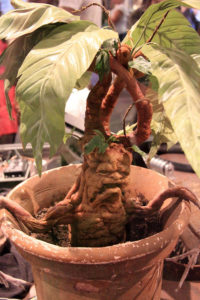
In the Harry Potter series, mandrakes have powerful restorative properties. (Photo by Karen Roe [Flickr])
Mandrake
Mandrake, or mandragora, is a plant with a root that looks like a human. When the plant is young, the root resembles a baby, but as it matures, it appears older. The unique plant is introduced in the second-year herbology curriculum at Hogwarts.
Mandrakes can act as a prime ingredient in the Mandrake Restorative Draught, a cure for staff and students who have been petrified. The plant can also be used in potions and antidotes. But beware: The cry of the mandrake is fatal to anyone who hears it.
In the real world, mandrake roots originated in the Mediterranean and are part of the nightshade family. This is the same family that gives us potatoes, eggplants, peppers, and tomatoes.
Devil’s Snare
Devil’s snare is known for its tentacle-like appendages and its aversion to light and fire. The plant has a magical ability to strangle or constrict anything in its environment. When you resist the plant’s grasp, it just grips tighter. Snares prefer damp, dark environments and will recoil from bright light or fire.
The deadly plant is similar to jimson weed in the real world. Also part of the nightshade family, jimson weed can cause blurred vision, hallucinations, comas, and even death.
Gillyweed
Native to the Mediterranean Sea, gillyweed is a magical plant that resembles a bundle of gray-green, slimy rat tails. When the plant is consumed by a witch or wizard, they will grow gills that allow them to breathe underwater. The effects of gillyweed typically last about one hour.
In real life, gillyweed is similar to swamp pink. Listed as a threatened species in 1988, swamp pink is a member of the lily family and grows in wetlands.
Wolfsbane
Wolfsbane, also known as aconite or monkshood, is a prime ingredient in Wolfsbane Potion. The highly toxic plant is used in the films to help werewolves get through their monthly transformation without violence. The Wolfsbane Potion was also used as an ingredient in the Wideye or Awakening Potion.
In the series, the plant looks similar to its real-life counterpart, with deep purplish-blue blooms. Aconitum, commonly known as wolfsbane, is a perennial native to the mountainous parts of the Northern Hemisphere. There are more than 250 species of these flowering plants, and most are extremely poisonous.
Belladonna
Belladonna goes by many names, including atropa, dwale, death’s herb, deadly nightshade, and witch’s berry. In potions class at Hogwarts, the essence of the poisonous plant is a component of their standard potion-making kit.
In reality, belladonna is one of the most toxic plants in the Western Hemisphere. It was used in ancient times to create poisonous arrows. The plant is also a source of atropine, a drug that is used in eye operations to dilate the pupil.
Bubotubers
Covered in shiny protrusions, bubotubers resemble large, thick slugs. When squeezed, the plant emits thick, green-yellow pus with an odor similar to gasoline. The pus of a bubotuber is an effective topical treatment for severe acne.
While the bubotuber is a one-of-a-kind plant, there are several herbs in the real world that provide similar skin benefits. For instance, manjistha is a perennial climber used in Ayurvedic medicine. The plant is believed to support the lymphatic system, resulting in healthy skin. With its antibacterial, anti-inflammatory, and anti-androgenic abilities, it has been found useful in preventing and treating acne.
